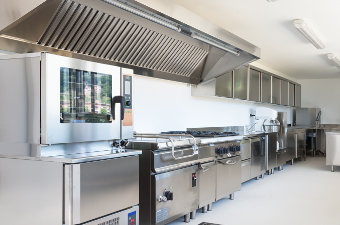Commercial Steam Cookers
Last Updated: 02/26/24
Also referred to as a “compartment steamer,” a device with one or more food steaming compartments in which the energy in the steam is transferred to the food by direct contact. Models may include countertop models, wall-mounted models and floor-models mounted on a stand, pedestal or cabinet-style base.
 Product Details
Product Details
To the maximum extent practicable, federal agencies are required to buy sustainable products, which are products that meet the purchasing program(s) listed below.
If there is more than one program listed below, agencies are directed to prioritize multi-attribute products, which meet statutory purchasing program requirements (![]() ) and one or more required Environmental Protection Agency purchasing programs.
) and one or more required Environmental Protection Agency purchasing programs.
Review our frequently asked questions for more information.
|
Procurement Info
|
Where to Buy
|
|---|---|
 Legal Requirements
Lists federal requirements related to the purchase of this item, including applicable Federal Acquisition Regulation (FAR) requirements
Legal Requirements
Lists federal requirements related to the purchase of this item, including applicable Federal Acquisition Regulation (FAR) requirements
 Life Cycle Cost Savings
Life Cycle Cost Savings
Life Cycle Costing (LCC) aims to quantify the financial impact of a product over its entire life cycle to assist consumers in making decisions that will save them money over the long term.
An efficient product is cost effective when the utility costs saved over the life of the product exceed the additional upfront cost (if any) of the more efficient model. Energy Star considers both upfront costs and lifetime energy cost savings when setting required efficiency levels. Federal purchasers can assume that Energy Star-qualified products are life-cycle cost effective.
To calculate life cycle cost savings, explore these tools:
- On its Purchasing & Procurement page
 , Energy Star offers MS-Excel-based calculators to estimate how much money and energy you can save purchasing ENERGY STAR commercial food service equipment.
, Energy Star offers MS-Excel-based calculators to estimate how much money and energy you can save purchasing ENERGY STAR commercial food service equipment. - For life cycling costing on specific brand-name products, visit SFTool Product Search by clicking the green box at the top of this page. Once you have created an account, add a product to a project and open the project. The tool displays energy cost savings, adjusting for local utility rates, operating conditions, and the purchase price.
- NREL’s Levelized Cost of Energy Calculator
 can help estimate the cost of electricity as an input for your lifecycle cost calculations, accounting for both cost escalation and discount rates.
can help estimate the cost of electricity as an input for your lifecycle cost calculations, accounting for both cost escalation and discount rates.


 Energy Star
Energy Star